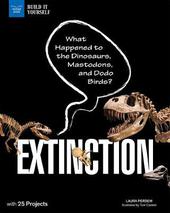
|
Extinction: What Happened to the Dinosaurs, Mastodons, and Dodo Birds? With 25 Projects
Hardback
Main Details
| Title |
Extinction: What Happened to the Dinosaurs, Mastodons, and Dodo Birds? With 25 Projects
|
| Authors and Contributors |
By (author) Laura Perdew
|
|
Illustrated by Tom Casteel
|
| Physical Properties |
| Format:Hardback | | Pages:128 | | Dimensions(mm): Height 254,Width 204 |
|
| ISBN/Barcode |
9781619305571
|
| Classifications | Dewey:576.84 |
|---|
| Audience | |
|---|
|
Publishing Details |
| Publisher |
Nomad Press
|
| Imprint |
Nomad Press
|
| Publication Date |
15 September 2017 |
| Publication Country |
United States
|
Description
In Earth's 4.5-billion-year history, more than 5 billion species have gone extinct, some of them at the same time. How can 75-95 percent of species on Earth disappear at one time? What event could cause such a massive die off? These are the questions that scientists have asked for decades as they explore the causes of extinction. In Extinction: What Happened to the Dinosaurs, Mastodons, and Dodo Birds? readers ages 9 to 12 learn about the scientific detective work scientists perform to answer these questions and find the culprit behind mass extinctions.
Author Biography
Laura Perdew is an author, writing consultant, and former middle school teacher. She has written more than 15 books for the education market on a wide range of subjects, including the animal rights movement, the history of the toilet, eating local, and the Great Pacific Garbage Patch. She is a long-time member of the Society of Children's Book Authors and Illustrators. Laura lives in Boulder, Colorado.Tom Casteel is an illustrator and cartoonist with a master's degree from the Center for Cartoon Studies. Tom has illustrated several books for Nomad Press, including The Brain: Journey Through the Universe Inside Your Head; Cities: Discover How They Work; and Human Migration: Investigate the Global Journey of Humankind. Tom lives in South Bend, Indiana.
ReviewsReviews for other titles in the series: BioEngineering: Discover How Nature Inspires Human Designs School Library Connection: Breaking down the complex topic of bioengineering into a kid-friendly format is a tough challenge, and Dr. Christine Burillo-Kirch does a fine job of doing just that. Bioengineering, the field which combines biology and engineering to build devices that help humans, is carefully defined and explained for upper elementary and middle school students. The text and comic style illustrations support science and STEM curriculum and projects while keeping it relatable and simple for budding scientists. The 25 projects, complete with supply lists and step-by-step directions, give students and teachers guidelines for meaningful projects and activities to extend learning and spark critical thinking. Recommended. Reviews for other titles in the series: Microbes: Discover an Unseen World with 25 Projects Booklist: Making microbes an engaging topic for young readers is no easy task, but by marshaling comic-book-style illustrations and plenty of relatable examples, this book will be an appealing choice for the science classroom and the library shelf. Essential questions are introduced at the start of each chapter and are repeated at that chapter's close to reinforce the main concepts and encourage metacognition. Twenty-five experiments expound on concepts such as understanding herd immunity, viewing bacteria cultures, diagnosing infectious disease, and studying decomposition. Access to more information is made easy through the scannable QR codes and keyword search prompts that are embedded in the marginalia. By discussing the ways the microbes grow and thrive, this offers plenty of practical advice for staying healthy and preventing infection. As a series of fun experiments in a dynamic layout that also remains faithful to the basic tenets of scientific inquiry, this is sure to engage young biologists. Alexander's Library Finally! A book about paleontology that begins with a geological time scale stretching from Earth's beginning (about 4.6 billion years ago) to the present. Not only does the timeline map out eras, periods, and epochs, it also places the last five mass extinctions into context. Fortunately, the introductory chapter defines what an extinction is, detailing contemporary extinctions of species. Subsequent chapters examine causes of extinction, asteroid strikes, human evolution, and other examples of survival and adaptation. The author raises the possibility that we may currently be experiencing the sixth mass extinction, pushed by human impact on the environment. This book is filled with hands-on activities, from making a fossil to examining how oceans are acidified (and the impact on shells). There's even a list of items to take on a (water) bear hunt. Additional features include text boxes that highlight fin facts; sidebars that provide definitions; and a series of species spotlights. What I really like: the last chapter lists concrete steps we can take to reduce human impact on our planet and slow the rate of species extinction. National Science Teachers Association Recommends This book uses the concept of extinction to teach a little chemistry, a little climatology, paleontology, biology (biodiversity), ecology, and a lot of geology. The science information is historical and current, drawing on three-dimensional learning*, incorporating science practices to determine what factors affect extinction in general and specifically. The integration of concepts help bring the science alive and relevant. I like the interactive side notes with website addresses and even more fun, QR codes. The QR codes link you to a variety of sources to dig deeper into specific content; these links alone make the book worthwhile to me. The activities include hands-on investigations, giving students opportunities to conduct experiments, to practice science while making connections, and to communicate their findings.
|